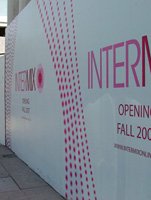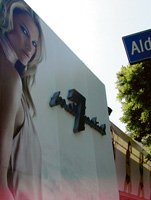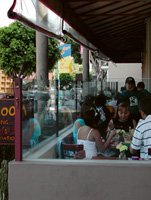Robertson Continues to Evolve Without Coach
Coach bags plans for a Roberston store, but the high-profile L.A. thoroughfare continues to draw new boutiques.
Coach Inc. pulled up its stakes from Robertson Boulevard. But the high-profile defection won’t stop the major changes transforming the premier Los Angeles shopping street.
New York–based Coach confirmed that it will not debut its Coach Legacy store at 112 S. Robertson Blvd. In February, the $2 billion luxury accessories label announced plans to open Coach Legacy concept stores on Robertson and on New York’s Bleeker Street.
The Bleeker Street Coach Legacy store will eventually open, according to a company representative who did not give a reason for shifting gears on Robertson.
However, Robertson businesses should not take Coach’s plans as a vote of no confidence. Some of the world’s top retailers have big plans for the street.
Chanel will build an accessories store at 125 N. Robertson. Stylish New York–based boutique Intermix is building an emporium on the north 100 block of the street. It is scheduled to debut Sept. 7.
Ralph Lauren has reportedly set its eyes on the building at 143 N. Robertson, which currently houses a big antiques store, according to the street’s commercial real estate agents, although a Ralph Lauren spokesperson said that the popular designer had no plans for the street at the present time.
Los Angeles–based premium-denim label 7 For All Mankind is scheduled to debut its first boutique on the south 100 block of the street in late autumn. The company stated that Robertson will be the perfect billboard for its upcoming chain of stores, according to retail vice president Aaron Battista.
Many high-profile fashion companies, including True Religion and United Kingdom–based Reiss, share Battista’s view about the shopping street. With deep pockets and a desire to move onto Robertson, these labels helped transform the place from a haven for hip multi-brand retailers, to a street dominated by branded stores and retailers with a national presence.
In the past four years, Robertson rents shot up from $7 per square foot to $20 per square foot, according to Matthew May, president of May Realty Advisors, based in Encino, Calif. Rodeo Drive fetches one of the highest prices in L.A. County, at $40 per square foot. Portions of Beverly Drive, which borders Rodeo, have properties that cost $10 per square foot.
The skyrocketing prices are driving independent retailers out, according to Fraser Ross, owner of Kitson, one of the pioneering boutiques on Robertson.
“It’s become corporate,” Ross said of the street. “Robertson can still be a unique place, but it needs independents to be unique.”
Competition to sell the best fashion lines has become fiercer than it has in the past, according to Ross. He will debut a new store in West Hollywood, Calif., possibly as early as Dec. 1. The 7,000-square-foot store’s working name is Kitson Melrose. It will sell men’s and women’s clothing and accessories and will be located on the 8500 block of West Melrose Avenue near Westbourne Drive.
Ross worried that if independents leave the street to branded stores, Robertson shopping will lose its unique character. Instead of offering the newest fashion lines, stores will offer styles that are available on any retail thoroughfare in the United States. Tourists and locals might greet this change by not visiting the street. If Ross is right, it would be a change for Robertson, which has become a symbol for luxury and celebrity over the past few years.
Celebrity magazines US Weekly and People helped build the reputation of the street by documenting young celebrities shopping the street and lunching at movie-industry boicirc;te The Ivy. Crowds of tourists and shoppers often followed them.
If the stars were attracted to the street’s hip fashion lines, the attention showered on the street made it influential enough to help shape fashion trends—such as the premium- denim craze—of the past decade.
However, Jamie Ross, a creative director at New York–based trend forecaster The Doneger Group, said shopping crowds will never abandon the street. Big names might just make the place more popular.
She has tracked shopping streets around the globe. Robertson might be following the same growth curve that New York’s SoHo neighborhood experienced.
SoHo was formerly dominated by independent, multi-line retailers with a forward-looking style. Over the past few years it has been dom- inated by branded boutiques and national chains, including True Religion, American Apparel and Ted Baker, all of which also have stores on Robertson.
Ross said she thought that many consumers were comforted by seeing familiar brands. “[In SoHo,] you can’t find a parking space there on weekends,” she said. “It’s out of control.”
Independent stores might benefit from doing business adjacent to national retailers. The high-marquee names might attract more consumers who might not learn about the independent retailers, according to Ross.
A continued game of retail musical chairs might dominate Robertson’s future, said May, the real estate broker who helped find space for True Religion’s Robertson space. The real estate boom of the past few years made desirable real estate in Los Angeles very valuable.
“Stores can make more money by selling their leases than running their businesses,” he said.
However, Robertson rents might have hit a plateau, said Chuck Dembo, partner with Beverly Hills–based Dembo & Associates. His commercial real estate company has been active on the street for years. He said that the price hikes have tapered off, a reaction to the skyrocketing real estate costs in the past few years.
Robertson will never be a typical retail street, he said. “I doubt if we’re going to see The Gaps and the Abercrombie & Fitches on Robertson,” Dembo said. “It’s too specialized of an area. They probably don’t want to pay the high rents.”
























